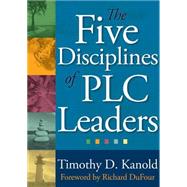
Note: Supplemental materials are not guaranteed with Rental or Used book purchases.
Purchase Benefits
What is included with this book?
| About The Author | p. xi |
| Foreword | p. xiii |
| Introduction: Professional Learning Community Leadership: Disciplined Leaders Required | p. 1 |
| The Paradoxes of Leadership | p. 2 |
| Training to Run the PLC Race | p. 3 |
| The Disciplined PLC Leader | p. 5 |
| The Five Disciplines of School Leadership | p. 5 |
| The Benefits of Leadership Discipline Training | p. 8 |
| The Discipline of Vision and Values | p. 11 |
| Connecting Your Personal Vision and Values to Daily Decision Making | p. 13 |
| Refining Your Personal Vision | p. 15 |
| Connecting Your Personal Passion to the Vision of Professional Learning Communities | p. 17 |
| Creating Vision Ownership for Sustainability | p. 19 |
| Teaching the Vision | p. 21 |
| Creating Vision Clarity | p. 22 |
| Creating Vision Alignment and Focus | p. 24 |
| Improving Vision Through Double-Loop Learning | p. 28 |
| Study Guide | p. 32 |
| The Discipline of Accountability and Celebration | p. 35 |
| The Courage to Do More Than Monitor | p. 39 |
| Monitoring the ôRight Thingsö | p. 40 |
| Getting to ôLoose-Tightö Leadership | p. 41 |
| Rejecting the Laissez-Faire Stance | p. 43 |
| Knowing What Is and Is Not a ôChoiceö | p. 44 |
| Defining Autonomy and Defending Boundaries | p. 46 |
| Turning Vision Into Action | p. 50 |
| Rejecting Victim Speak | p. 53 |
| Understanding Tiers of Accountability | p. 55 |
| Leading a Well-Designed System for Monitoring Continuous Improvement | p. 59 |
| Implementing the Continuous Improvement Model | p. 62 |
| Spending the Human Capital of Encouragement | p. 71 |
| The Tall Poppy Syndrome | p. 73 |
| Study Guide | p. 76 |
| The Discipline of Service and Sharing | p. 79 |
| Growing Emotional intelligence | p. 82 |
| Cultivating an N-S-E-W Sphere of Influence | p. 85 |
| Pursuing Level 5 Leadership | p. 88 |
| Showing Humility | p. 90 |
| Building an Expanded Leadership Base | p. 91 |
| Creating a Relational Culture | p. 94 |
| Study Guide | p. 117 |
| The Discipline of Reflection and Balance | p. 119 |
| Refusing to Multitask | p. 121 |
| Using Technology Strategically | p. 124 |
| Avoiding Excuses | p. 127 |
| Paying Attention to Students and Adults | p. 130 |
| Providing Motivation 3.0 | p. 134 |
| Pursuing Optimal Learning Experiences | p. 137 |
| Becoming Engaged and Reflective | p. 142 |
| Creating Balance | p. 147 |
| Pursuing Internal Balance | p. 150 |
| Study Guide | p. 154 |
| The Discipline of Inspiration and Influence | p. 157 |
| The PLC Leader's Legacy | p. 159 |
| Responding to Failure | p. 163 |
| Preventing Deep Regret | p. 168 |
| Choosing the Path of Enduring Inspiration | p. 173 |
| PLC Leadership Inspiration Matters | p. 179 |
| PLC Leaders Are Remembered for What They Do for Others | p. 180 |
| Study Guide | p. 182 |
| Epilogue: The Professional Learning Community as a School Movement | p. 185 |
| References And Resources | p. 189 |
| Index | p. 195 |
| Table of Contents provided by Ingram. All Rights Reserved. |
The New copy of this book will include any supplemental materials advertised. Please check the title of the book to determine if it should include any access cards, study guides, lab manuals, CDs, etc.
The Used, Rental and eBook copies of this book are not guaranteed to include any supplemental materials. Typically, only the book itself is included. This is true even if the title states it includes any access cards, study guides, lab manuals, CDs, etc.